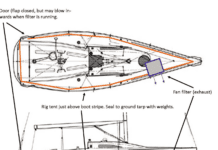I think of sailing as a lifelong pursuit. Mastery of sailing is elusive, there is always more to learn, from leading a new position on a boat you’re familiar with, to learning how to perform maintenance on a part or system on your vessel, there are always more ways to improve your knowledge. For example, once you learn how to sail a symmetrical spinnaker, you can then learn how to sail an asymmetrical spinnaker. While you may know your home waters and weather systems, as you sail in more locations you will always be learning about the local tides and weather patterns around the world.
To continue reading this article or issue you must be a paid subscriber. Sign in
Subscribe to Practical Sailor
Get full access to Practical Sailor - over 4,000 articles - for just $34.
Subscribe today and save 42% off the annual rate.






































Sorry – I did not have enough time to read this piece – I was so turned off by the section headlines. I spent early summers sailing on Buzzards Bay but I freely acknowledge that this author is a much better sailor than I, though he’s from the big country. I was seeking concrete advice – eg, when there’s a bit too much wind,
trim the jib and luff the main
and you’ll be fine in in Frisco or Maine